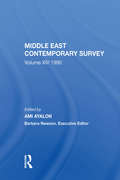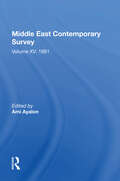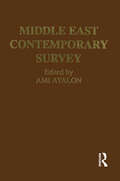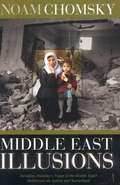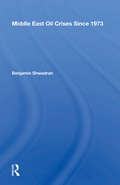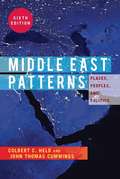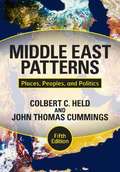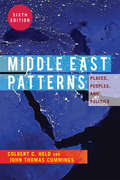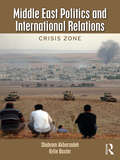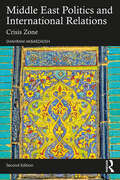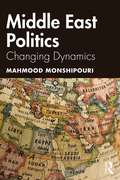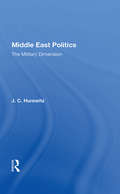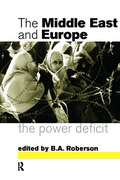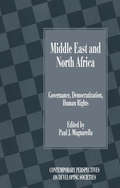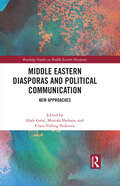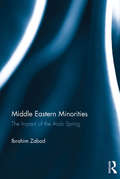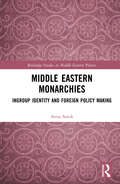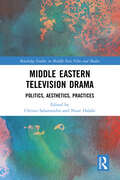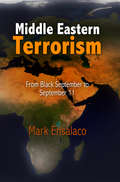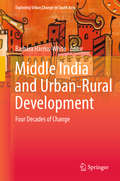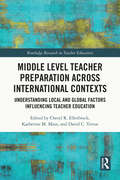- Table View
- List View
Middle East Contemporary Survey, Volume Xiv: 1990
by Ami AyalonThis annual record of political developments in the Middle East is designed as a continuing, up-to-date reference for scholars, researchers and analysts, policy-makers, students and journalists. It examines in detail the rapidly-changing Middle-Eastern scene in all its complexity. This volume covers the eruption of the Gulf crisis and the war that had dramatic effects on all the countries of the Middle East.
Middle East Contemporary Survey, Volume Xv: 1991
by Ami AyalonThis is the fifteenth volume in a series that provides up-to-date summation and evaluation of the rapidly changing events in an exceptionally complex region of the world. This volume covers the period January through December 1991 and offers in-depth analysis of the Gulf War, the U.S.-inspired peace negotiations, the surge of Islamic sentiment in a number of countries, and inter-Arab relations in the wake of the Gulf War. In addition, a comprehensive survey of the affairs of each country is provided. This volume covers the year 1991, a watershed period in the Middle East. The Gulf War pitted regional and international forces of unprecedented might against each other in fierce confrontation. Local and global developments, such as the U.S.-led victory over Iraq and the disintegration of the Soviet Union, brought on the struggle for a new order in the region. The relevance of Western political modes for Middle Eastern societies was again raised for examination, highlighting the formidable complexities of such options. One of the local responses to these changes was a surge of Islamic sentiment sometimes militant in nature manifested primarily in Sudan, Algeria, Jordan, Egypt, and among the Palestinians. Spearheaded by the United States, the Middle East peace process entered a more dynamic phase, as a multilateral peace conference in Madrid ushered in a new era of direct Arab-Israeli negotiations. The Arab system was slow to recover from the painful impact of the Gulf War, and inter-Arab relations continued to be characterized more by mutual vindictiveness than by reconciliation. On the whole, this was a year of considerable flux and uncertainty, with some events promising the inauguration of a new course of development for the region and others passing without long-term impact. The period surveyed in this volume, unless otherwise indicated, is from January to December 1991. In order to avoid excessive repetition while achieving a comprehensive survey of the affairs of each country individually, extensive cross-references have been used
Middle East Contemporary Survey, Volume Xvi, 1992
by Ami AyalonA number of contributors explore contemporary Middle East countries and look at how and if, they have moved forward. It looks at the rise of religious extremists and the Arab-Israeli peace process, stimulated by the change of government in Israel.
Middle East Illusions: Reflections on Justice and Nationhood
by Noam ChomskyWhat are the roots of the Israel-Palestinian conflict and how has it been influenced by the United States? Why has the U.S.-brokered "peace process" repeatedly failed to deliver peace? What are the prospects for a just resolution? What interests underlie current U.S. strategic doctrines in the Middle East, especially in its redeclared "war on terrorism" after 9-11, and how do we look beyond them to find more peaceful and viable alternatives? These are among the current and long-standing questions Noam Chomsky takes up in his newest book. Middle East Illusions presents recent chapters written by the author about the myths behind the peace process, the second Palestinian Intifada (which began in September 2000 and continues today in defiance of Israeli repression), and the Bush administration's response to the September 11 attacks on the United States, including its drive toward another war with Iraq. Middle East Illusions also includes the full text of Chomsky's earlier book, Peace in the Middle East? Reflections on Justice and Nationhood, written during the crucial period spanning the Six-Day and 1973 wars, events that continue to define and deeply influence the world today. It therefore presents in-depth analysis covering several decades, making it one of the richest of any analysis published about the region's geopolitics. Noam Chomsky is recognized internationally for his critical analysis of the Middle East. His thoroughly documented research draws on an immense range of sources, including Hebrew texts rarely discussed in the United States, declassified government planning documents, and other sources all too often overlooked in discussions of the U.S. role in the Palestinian-Israeli conflict.
Middle East Oil Crises Since 1973
by Benjamin ShwadranThe production and consumption of oil has emerged as a major factor in international economics in general and in regional and national development in particular. The struggle for access to oil and gas resources has become even more fierce, affecting the long-range strategic planning of the superpowers and causing a shift in the world balance of trade. Middle East Oil Crises Since 1973 is the logical sequel to Dr. Shwadran's classic, The Middle East, Oil and the Great Powers. In this new work, Dr. Shwadran delineates the changes in the power equation, the political atmosphere, and the resources of the participants since 1973. He marshals persuasive evidence to show that economic forces, narrow vision, and the absence of strategic planning were the major contributing factors for the oil crises of the past decade, rather than the Arab-Israeli war.
Middle East Patterns
by Colbert C. Held John Thomas Cummings Cartography by John V. CotterNow in its sixth edition, Middle East Patterns continues to be the most comprehensive and authoritative geographical study of the region. Colbert C. Held and John Thomas Cummings introduce the Middle East from a topical perspective and then provide in-depth country-by-country coverage. The sixth edition maintains the book’s well-received framework and distinctive focus on a wide range of geographical patterns--ethnographic, economic, and political--while integrating updated comparative material on natural resources and human and social development. New sections on health issues, business environments, and the historical US presence in the region expand the book’s ample coverage. Richly illustrated with more than 125 photos and 70 maps, this acclaimed book remains the best accessible resource for students and general readers who seek to understand the spatial dynamics of the Middle East. Visit middleeastpatterns. com for historical timelines, archived content from the fifth edition, and updated material on current situations in the Middle East.
Middle East Patterns
by Colbert C. Held John Thomas CummingsAuthor Held, a former foreign-service officer in the region, joins with new co-author Cummings, a former USAID economist, in this overview for students and general readers, especially those preparing to live and work in the Middle East. The book can be used for courses in the geography of the Middle East. Part 1 describes the climate and environment of the region and traces its historical-geographical, political, and cultural evolution. This section also examines agriculture, petroleum manufacturing, industry, and geopolitics. Part 2 offers profiles of 11 countries and sub-regions, showing economic patterns, political geography, and demographics, with special attention paid to the Palestinian-Israeli conflict. This fifth edition is rewritten to take into account developments over the past five years, with new material on terrorism and the effects of development on women. This edition also adds 16 new photos to the 100+ b&w photos taken by Held during his 50 years of fieldwork and diplomatic assignments in the Middle East. Held is a former diplomat-in-residence at Baylor University, Annotation ©2011 Book News, Inc. , Portland, OR (booknews. com)
Middle East Patterns
by Colbert C. Held John Thomas CummingsNow in its sixth edition, Middle East Patterns continues to be the most comprehensive and authoritative geographical study of the region. Colbert C. Held and John Thomas Cummings introduce the Middle East from a topical perspective and then provide in-depth country-by- country coverage. The sixth edition maintains the book's well-received framework and distinctive focus on a wide range of geographical patterns-ethnographic, economic, and political-while integrating updated comparative material on natural resources and human and social development. New sections on health issues, business environments, and the historical US presence in the region expand the book's ample coverage. Richly illustrated with more than 125 photos and 70 maps, this acclaimed book remains the best accessible resource for students and general readers who seek to understand the spatial dynamics of the Middle East. Visit www.middleeastpatterns.com for historical timelines, archived content from the fifth edition, and updated material on current situations in the Middle East.
Middle East Patterns
by Colbert C. Held John Thomas CummingsNow in its fifth edition, Middle East Patterns continues to be the most comprehensive and authoritative geographical study of the region. New coauthor John Thomas Cummings joins Colbert C. Held in updating this classic work while retaining the well-received framework of past editions. The authors first cover the Middle East from a topical perspective, considering the region's biophysical, ethnographic, economic, and geopolitical patterns, and then provide in-depth country-by-country coverage. The fifth edition maintains the book's distinctive focus on geography, natural resources, and land-use patterns while integrating updated comparative material on development economics and political economy throughout the book, as well as new sections on terrorism and piracy and the effects of development on women's health issues. Richly illustrated with more than 100 photos and 60 maps, this acclaimed book remains the best accessible resource for students and general readers who seek to understand the spatial dynamics of the Middle East.
Middle East Patterns, Student Economy Edition: Places, People, and Politics
by Colbert HeldNow in its sixth edition, this classic text continues to be the most comprehensive and authoritative geographical study of the region.
Middle East Patterns: Places, People, and Politics
by Colbert C. HeldThis book covers the Middle East from a topical or systematic perspective focusing on the states of the Gulf and southern Arabian Peninsula. It includes the dramatic developments in the Arab world across North Africa and in the heart of the Middle East since late 2010 termed as the "Arab Spring.".
Middle East Politics and International Relations: Crisis Zone
by Shahram Akbarzadeh Kylie BaxterThe contemporary Middle East has been defined by political crises and conflict. The interplay of internal and external factors have set the region on a path of turmoil and crisis with devastating outcomes for its people. The absence of political accountability and representation, and policies pursued by the United States to keep US-friendly regimes in power have been two key factors that have contributed to the seemingly insoluble Middle East politics. This book provides a detailed exploration of the forces, internal and external, that have shaped today’s Middle East. The book follows a chronological order and provides context to major political milestones. Topics explored include: • Imperialism in the Middle East • The formation of the State of Israel • The Arab–Israeli wars • Palestinian politics and the failure of the ‘peace process’ • The Iranian Revolution and pan-Shi’ism • Superpowers in the Middle East • The US-led ‘War on Terror’ • The Arab uprisings • The Syrian War and the rise of the ‘Islamic State’ • US–Iran relations This study puts recent developments in historical context, and will serve as a core reference tool for students and researchers of Middle Eastern Politics and International Relations.
Middle East Politics and International Relations: Crisis Zone
by Shahram AkbarzadehContinuing civil wars and humanitarian crises, coupled with a changing geopolitical dynamic, highlighted by increased Russian and Chinese presence in the Middle East, call for new thinking. What happens in the Middle East has major global repercussions. This second edition of the ground-breaking textbook Middle East Politics and International Relations: Crisis Zone provides a comprehensive overview of contemporary Middle East politics. The book traces the roots of recent events across the region’s modern history, enabling readers to appreciate both the significance of such events and the importance of history in influencing their outcomes. Structured chronologically, with updated stand-alone chapters containing history, context and contemporary analyses, this edition examines a series of interconnected themes and issues, including external intervention, political manifestations of Islam, the role of political authority, nationalism, self-determination and human rights. The book provides a valuable teaching tool, both in its content and structure. Students will gain a deeper understanding of a changed Middle East and the evolving role of states and non-state actors in the region.
Middle East Politics: Changing Dynamics
by Mahmood MonshipouriAimed at undergraduate-level courses, this brand-new textbook provides an overview of Middle Eastern politics, offering in-depth examination of the forces of stability, change, uncertainty, and progress in the region. Building on both historical and contemporary analysis, the chapters are timely, engaging, and provocative, covering topics such as: Turmoil and transition in Middle Eastern politics The Arab-Israeli conflict The Persian Gulf and global security The rise of the internet Terrorism and the Islamic State US-Iran relations The role of new regional players, such as China, India, and Russia Increasing investment in wind and solar energy in the post-carbon era. Providing a unique perspective on the major themes and current state of knowledge about the region, this new textbook will be invaluable to students of Middle Eastern politics.
Middle East Politics: The Military Dimension
by J. C. HurewitzThe Arab-Israel Six Day War in June 1967 riveted world attention on the huge quantities of sophisticated weapons amassed in the arsenals of the Middle East – and left in its wake tangled political-military dilemmas and the intensification of the most dangerous arms race in the nonindustrialized world. How do major upheavals spread across borders so easily in the Middle East? What is the role of the military in the process of modernization? How can the rash of military coups be explained? Why is Israel, the most vigorous democracy in the Middle East, also the most vigorously mobilized and armed nation? J. C. Hurewitz, Professor of Government at Columbia University’s School of International Affairs, believes the answers to these and other pressing questions of Middle Eastern politics can be found only in a thorough examination of civil-military relations in each country, whether it is under military rule or not. The Middle East, as defined in this book, comprises eighteen states, stretching from Morocco to Afghanistan and Pakistan. Probing the role of the military in each state, the author assesses such other factors as the geographical and regional influences on specific national developments. Dominating all are the ramifications of the competing American and Soviet policies for the region. Through his analysis of the cold war tactics of the two Great Powers, and of the bewildering arms races and the confusion of military politics that these tactics have engendered, Professor Hurewitz brings into much clearer perspective the options for the West, and particularly for the United States, in this area. He has provided, in sum, an informative and fully documented study of the whole interplay of domestic, regional, and international politics in the postwar Middle East.
Middle East and Europe: The Power Deficit
by B. A. RobersonLeading commentators on Europe and the Middle East explore many of the key issues which have informed the relationship between the two regions. Ranging from Europe's colonial legacies to an uncertain economic future in the region the book covers:* the Cold War and after* the profound influence of the US* the rise of political Islam* case studies including Europe and the Iranian revolution, France's experiences in Algeria, and Turkey's position between the two regions.The EU, it is argued, has more influence over economic strategies than security issues in the Middle East. These strategies have in turn promoted stability in the form of free trade zones, ensuring vital economic development between the Middle East and Europe.
Middle East and North Africa: Governance, Democratization, Human Rights (Contemporary Perspectives on Developing Societies)
by Paul J. MagnarellaThis collection contains articles by highly regarded scholars assessing governance, democratisation and human rights in the contemporary Middle East and North Africa. It also assesses the role that Islam plays in these areas. In the spirit of the 50th anniversary year of the United Nations Declaration of Human Rights, the authors examine the interrelationships among Islam, politics and human rights and evaluate each country’s contemporary record. The book contains in-depth articles on Islam and politics, Syria, Iraq, Jordan, Israel, the West Bank and Gaza, the Gulf States, Turkey, Egypt and the Maghreb (Morocco, Algeria, Tunisia, Libya and Mauritania). The authors discuss recent political developments in each of these countries and point out their accomplishments and shortcomings in the area of human rights.
Middle Eastern Diasporas and Political Communication: New Approaches (Routledge Studies on Middle Eastern Diasporas)
by Ehab Galal Mostafa Shehata Claus Valling PedersenThis edited book explores the development and reconfiguration of Middle Eastern diasporic communities in the West in the context of increased political turmoil, civil war, new authoritarianism, and severe constraints on media in the Middle East. Taking an interdisciplinary approach, incorporating political and intercultural communication, the contributors investigate the rationale for diasporic politics, as well as the role of the transnational media in shaping diasporic political mobilization. This analysis of the media, situated within specific case studies, encompassing Afghani, Armenian, Bahraini, Egyptian, Lebanese, Syrian, Tunisian, and Turkish diasporic communities, reveals the variegated ways it influences diasporic politics and facilitates political action, as well as its influence on democratic actors residing in the Middle East. These new insights into Middle Eastern diasporas, political communication, and political mobilization are based on developments in the Middle East since 2011, and ultimately highlight how diaspora groups in the West relate to the situation in the Middle East, particularly in their countries of origin. The book is important reading for students and researchers working in political/intercultural communication and diasporic politics, as well as those with a general interest in the Middle East.
Middle Eastern Minorities: The Impact of the Arab Spring
by Ibrahim ZabadThis is a comprehensive survey of minorities in the Middle East with a special focus on the post Arab Spring era.Minority communities in the Middle East are the most susceptible to the turbulence engulfing the region; the majority may suffer physical violence and socioeconomic loss, but minorities could potentially vanish. Instead of ushering in democracy and inclusive politics, the revolutionary upheavals have prompted chaos and fear and reinforced the resurgence of Islamic fundamentalism throughout the region. Zabad uses historical sources as well as first-hand interviews to vividly describe the current status of minorities in the Middle East, explaining attitudes towards the revolutionary upheavals as well as the various strategies they used to avail themselves of the opportunities presented and to confront the risks posed. The question of ethnic, sectarian and religious minorities is situated in the context of the broader history of the region in order to explain the underlying institutional and ideological factors that caused their predicament and problematized their relationship with the majority.The book providesa rich trove of information and insights generated from ten case studies that covered the Shī‘a in Saudi Arabia, Bahrain, Lebanon and Egypt, the Druze, the Alawites, Christians and Kurds in Syria, the Copts in Egypt, and the Zaydis in Yemen.
Middle Eastern Monarchies: Ingroup Identity and Foreign Policy Making (Routledge Studies in Middle Eastern Politics)
by Anna SunikThe monograph explores the dynamics of ingroup identity in the foreign policy-making of Middle Eastern monarchies from the evolution of the regional system after the World Wars until the present. Utilising an innovative theoretical framework that combines Foreign Policy Analysis in the context of authoritarian regimes and Social Identity Theory, the book theorizes the origins and inner workings of a "monarchic peace" among hereditary regimes in the Middle East, including the Gulf monarchies as well as Jordan and Morocco. While the phenomenon of the "democratic peace" is well established in political science, this book argues that like the examined "monarchic peace", it is, in fact, a sub-case of a broader Similar Political Systems Peace (SPSP). The theory posits that monarchies do not wage war against each other because they recognize each other as members of the same "ingroup" which allows for other mechanisms of conflict resolution – behaviour that is allowed against outsiders might be prohibited against members of the same club or "family". The theory is illustrated with numerous case studies that look at overall regional dynamics as well as four crucial cases of monarchic interstate conflict: Bahraini-Qatari relations, the Saudi-Hashemite rivalry, and the relations between Kuwait and Iraq and Iran and the UAE. This in-depth account of the foreign policies and community, connecting Middle Eastern monarchies will be of interest to readers in international relations, authoritarianism studies, Middle East and Persian Gulf politics.
Middle Eastern Television Drama: Politics, Aesthetics, Practices (Routledge Studies in Middle East Film and Media)
by Nour Halabi Christa SalamandraThis monograph explores and investigates key issues facing Middle Eastern societies, including religion and sectarianism, history and collective memory, urban space and socioeconomic difference, policing and securitization, and gender relations. In the Middle East, television drama creators serve as public intellectuals who, with uncanny prescience, tell the world something. As this volume demonstrates, fictional television provides a crucial space for social and political debate in much of the region. Writing from a range disciplines—anthropology, communication, folklore, gender studies, history, and law— contributors include seasoned academics who have dedicated their careers to researching Middle Eastern media and emerging scholars who build on earlier work and introduce fresh perspectives. Together, they provide an invaluable overview of Middle Eastern serial television and their political impact, drawing examples from Afghanistan, Egypt, Iran, Syria, and Turkey. Bringing together a diverse range of academic perspectives, this book will be of key interest to students and scholars in media and communication studies, Middle Eastern Studies, and popular culture studies.
Middle Eastern Terrorism
by Mark EnsalacoSelected by Choice magazine as an Outstanding Academic TitleSince the first airplane hijacking by the Popular Front for the Liberation of Palestine in September 1970, Middle Eastern terrorists have sacrificed innocent human lives in the name of ideology. From Black September to the Munich Olympics, to the embassy bombing in Beirut, to the devastating attacks of September 11 and beyond, terrorism has emerged as the most important security concern of our time."Where did this come from?" Inspired by a student's question on the morning of September 11, 2001, Mark Ensalaco has written a thoroughly researched narrative account of the origins of Middle Eastern terrorism, addressing when and why terrorists started targeting Americans and American interests and what led to the September 11 attacks.Ensalaco reveals the changing of motivations from secular Palestinian nationalism to militant Islam and demonstrates how competition among terrorists for resources and notoriety has driven them to increasingly extreme tactics. As he argues, terrorist attacks grew from spectacle to atrocity. Drawing on popular works and scholarly sources, Middle Eastern Terrorism tells this story in rich detail and with great clarity and insight.
Middle Income Access to Justice
by Lorne Sossin M. Trebilcock Anthony DugganThough most conceptions of the rule of law assume equality before the law - and hence equal access to the justice system - this basic right is not being met for many low and middle income Canadians. This book focuses on the problem of civil access to justice for middle income earners - those whose household income is high enough to disqualify them from legal aid but not high enough to cover the costs of litigation. Featuring contributions by leading Canadian and international scholars, practitioners, and members of the judiciary, this multidisciplinary collection draws on scholarship in the fields of law, social science, and public policy. There is a particular emphasis on family law, consumer law, and employment law, as these are the areas where research has indicated that unmet legal needs are highest.Middle Income Access to Justice presents a variety of innovative solutions, from dispute resolution process reforms to the development of non-lawyer forms of assistance and new methods for funding legal expenses. In doing so, it lays the foundation for the development of a much-needed new delivery model to provide early intervention for legal services.
Middle India and Urban-Rural Development
by Barbara Harriss-WhiteMiddle India and Rural-Urban Development explores the socio-economic conditions of an 'India' that falls between the cracks of macro-economic analysis, sectoral research and micro-level ethnography. Its focus, the 'middle India' of small towns, is relatively unknown in scholarly terms for good reason: it requires sustained and difficult field research. But it is where most Indians either live or constantly visit in order to buy and sell, arrange marriages and plot politics. Anyone who wants to understand India therefore needs to understand non-metropolitan, provincial, small-town India and its economic life. This book meets this need. From 1973 to the present, Barbara Harriss-White has watched India's development through the lens of an ordinary town in northern Tamil Nadu, Arni. This book provides a pluralist, multi-disciplinary and inter-disciplinary perspective on Arni and its rural hinterland. It grounds general economic processes in the social specificities of a given place and region. In the process, continuity is juxtaposed with abrupt change. A strong feature of the book is its analysis of how government policies that fail to take into account the realities of small town life in India have unintended and often perverse consequences. In this unique book, Harriss-White brings together ten essays written by herself and her research team on Arni and its surrounding rural areas. They track the changing nature of local business and the workforce; their urban-rural relations, their regulation through civil society organizations and social practices, their relations to the state and to India's accelerating and dynamic growth. That most people live outside the metropolises holds for many other developing countries and makes this book, and the ideas and methods that frame it, highly relevant to a global development audience.
Middle Level Teacher Preparation across International Contexts: Understanding Local and Global Factors Influencing Teacher Education (Routledge Research in Teacher Education)
by David C. Virtue Cheryl R. Ellerbrock Katherine M. MainThis volume offers a cross-national analysis of teacher education programs designed to prepare teachers for work in middle level schools. The book showcases 15 detailed case studies of courses at institutions across North America, Europe, Asia, and Africa—including from countries currently underrepresented in middle level literature—which provide detailed information on programming whilst foregrounding the political, social, and cultural factors which have influenced priorities within teacher education. Underpinning the book is a comparative case study framework, used to identify divergences and commonalities within and across nations whereby factors such as globalization, policy, and socio-cultural views of teaching and adolescence are explored as determinants of the nature, success, and challenges of middle level teacher preparation. This text will benefit scholars, academics, and students in the fields of middle level education, teacher education, and international and comparative education. Those involved with educational policy and politics, as well as teacher training and the sociology of education more broadly, will also benefit from this volume.
